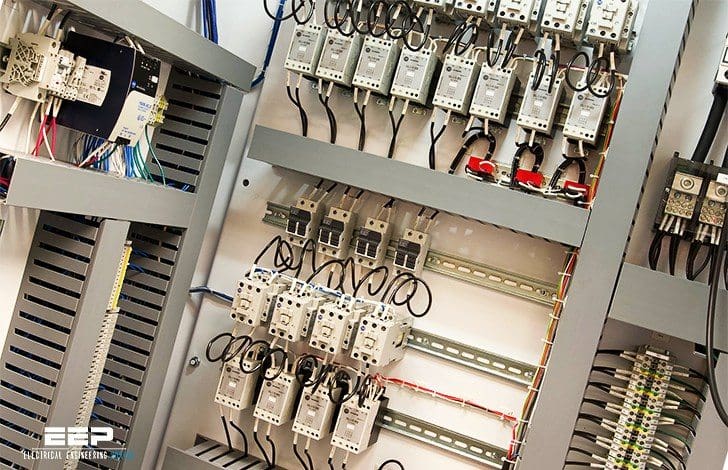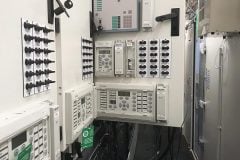Feeder circuit loads
Once the branch circuit loads are calculated, the feeder circuit loads may be calculated by applying demand factors to the branch circuit loads.
- General Lighting Loads (Article 220.42)
- Show window or track lighting (Article 220.43)
- Receptacles in other than dwelling units (Article 220.44)
- Motors (Article 220.50)
- Fixed Electric Space Heating (Article 220.51)
- Noncoincident Loads (Article 220.60)
- Feeder neutral load (Article 220.61)
- Continuous Loads (Article 215.3)

1. General Lighting Loads
(Article 220.42)
The feeder general lighting load can be calculated by multiplying the branch circuit general lighting load calculated per B.) 1.), for those branch circuits supplied by the feeder, by a demand factor per table 1 (NEC table 220.42).
Table 1 – Lighting load feeder demand factors (NEC [3] table 220.42)
| Type of Occupancy | Portion of Lighting Load to Which Demand Factor Applies (Volt-Amperes) | Demand Factor (Percent) |
| Dwelling units | First 3,000 or less at | 100 |
| From 3,001 to 120,000 at | 35 | |
| Remainder over 120,000 at | 25 | |
| Hospitals* | First 50,000 or less at | 40 |
| Remainder over 50,000 at | 20 | |
| Hotels and motels, including apartment houses without provision for cooking by tenants* | First 20,000 or less at | 50 |
| From 20,001 to 100,000 at | 40 | |
| Remainder over 100,000 at | 30 | |
| Warehouses (storage) | First 12,500 or less at | 100 |
| Remainder over 12,500 at | 50 | |
| All others | Total volt-amperes | 100 |
* The demand factors of this table shall not apply to the calculated load of feeders or services supplying areas in hospitals, hotels, and motels where the entire lighting is likely to be used at one time, as in operating rooms, ballrooms, or dining rooms.
2. Show window or track lighting
(Article 220.43)
Show windows must use a calculated value of 660 voltamperes per linear meter (200 volt-amperes per linear foot), measured horizontally along its base. Track lighting in other than dwelling units must be calculated at an 150 volt-amperes per 660mm (2 ft.) of lighting track or fraction thereof.
3. Receptacles in other than dwelling units
(Article 220.44)
Demand factors for non-dwelling receptacle loads are given in table 2 (NEC table 220.44).
| Portion of Receptacle Load to Which Demand Factor Applies (Volt-Amperes) | Demand Factor (Percent) |
| First 10 kVA or less at | 100 |
| Remainder over 10 kVA | 50 |
4. Motors (Article 220.50)
The feeder demands for these are calculated as follows:
The load calculation for several motors, or a motor(s) and other loads, is 125% of the full load current rating of the highest rated motor per II.) B.) ii.) above plus the sum of the full-load current ratings of all the other motors in the group, plus the ampacity required for the other loads (Article 430.24).
The load calculation for factory-wired multimotor and combination-load equipment should be based upon the minimum circuit ampacity marked on the equipment (Article 430.25) instead of the motor horsepower rating.
5. Fixed Electric Space Heating
(Article 220.51)
The feeder loads for these must be calculated at 100% of the connected load.
6. Non-coincident loads
(Article 220.60)
Where it is unlikely that two or more noncoincident loads will be in use simultaneously, it is permissible to use only the largest loads that will be used at one time to be used in calculating the feeder demand.
7. Feeder neutral load
(Article 220.61)
The feeder neutral load is defined as the maximum load imbalance on the feeder. The maximum load imbalance for three-phase four-wire systems is the maximum net calculated load between the neutral and any one ungrounded conductor. A demand factor of 70% may be applied to this calculated load imbalance.
Refer to NEC article 220.61 for neutral reductions in systems other than three-phase, four-wire systems. This demand factor does not apply to non-linear loads; in fact, it may be necessary to oversize the neutral due to current flow from non-linear load triplen harmonics.
8. Continuous Loads
(Article 215.3)
The rating of the overcurrent protection for a feeder circuit must be at least the sum of the non-continuous load +125% of the continuous load, unless the overcurrent device is 100%-rated. Because the rating of the overcurrent protection determines the rating of the branch circuit (Article 210.3), the branch circuit must be sized for the non-continuous load +125% of the continuous load.
Additional calculation data is given in NEC Article 220 for dwelling units, restaurants, schools, and farms.
As this article only presents the basic NEC requirements for load calculations, it is imperative to refer to the NEC itself when in doubt about a specific load sizing application. Computer programs are commercially available to automate the calculation of feeder and branch circuit loads per the NEC methodology described above.
References:
- Load Planning – Bill Brown, P.E., Square D Engineering Services
- IEEE Recommended Practice for Electric Power Distribution for Industrial Plants,
- IEEE Standard 141-1993, December 1993.
- Turan Gonen, Electric Power Distribution System Design, New York: McGraw-Hill, 1986, pp. 37-51
- The National Electrical Code, NFPA 70, The National Fire Protection Association, Inc., 2005 Edition
- IEEE Recommended Practice for Electric Power Systems in Commercial Buildings,
- IEEE Standard 241-1990, December 1990.











Have 6 rooftop units,
3- 5 ton @35amps 3 phase
3- 7.5 ton @ 50amps 3 phase
what size panel feeder do i need for ac panel
Helpful and specialized article … thanks
need power receptacles distribution in nondwelling buildings…..?
pls .I need to know the recommended distribution of power receptacles in building rather than the dwelling buildings-I mean the commertial ,Industrial…etc
Generally very informative and enables a clearer understanding of the fundamental behind the various available technical topics.
nice
very help full for me
It is interesting to share technical experiences n knowledge in our humble profession.
Awesome.
Hi Edvard Csanyi,
Ever since i subscribed on your EEP newsletter, i always enjoy your news.
I am a rapper and i have passion for electricity, please can you upload my music on one of your post.
Nice article